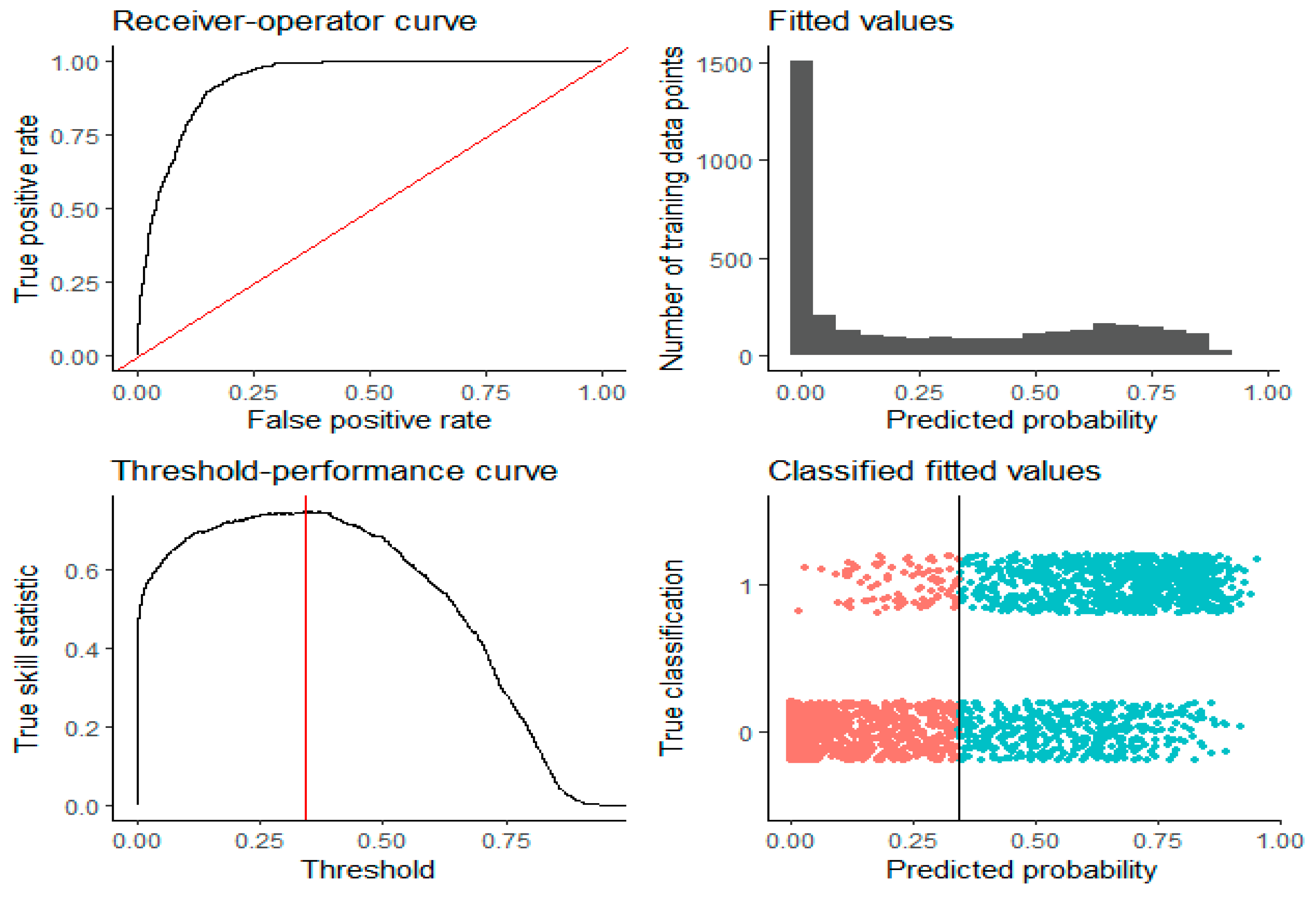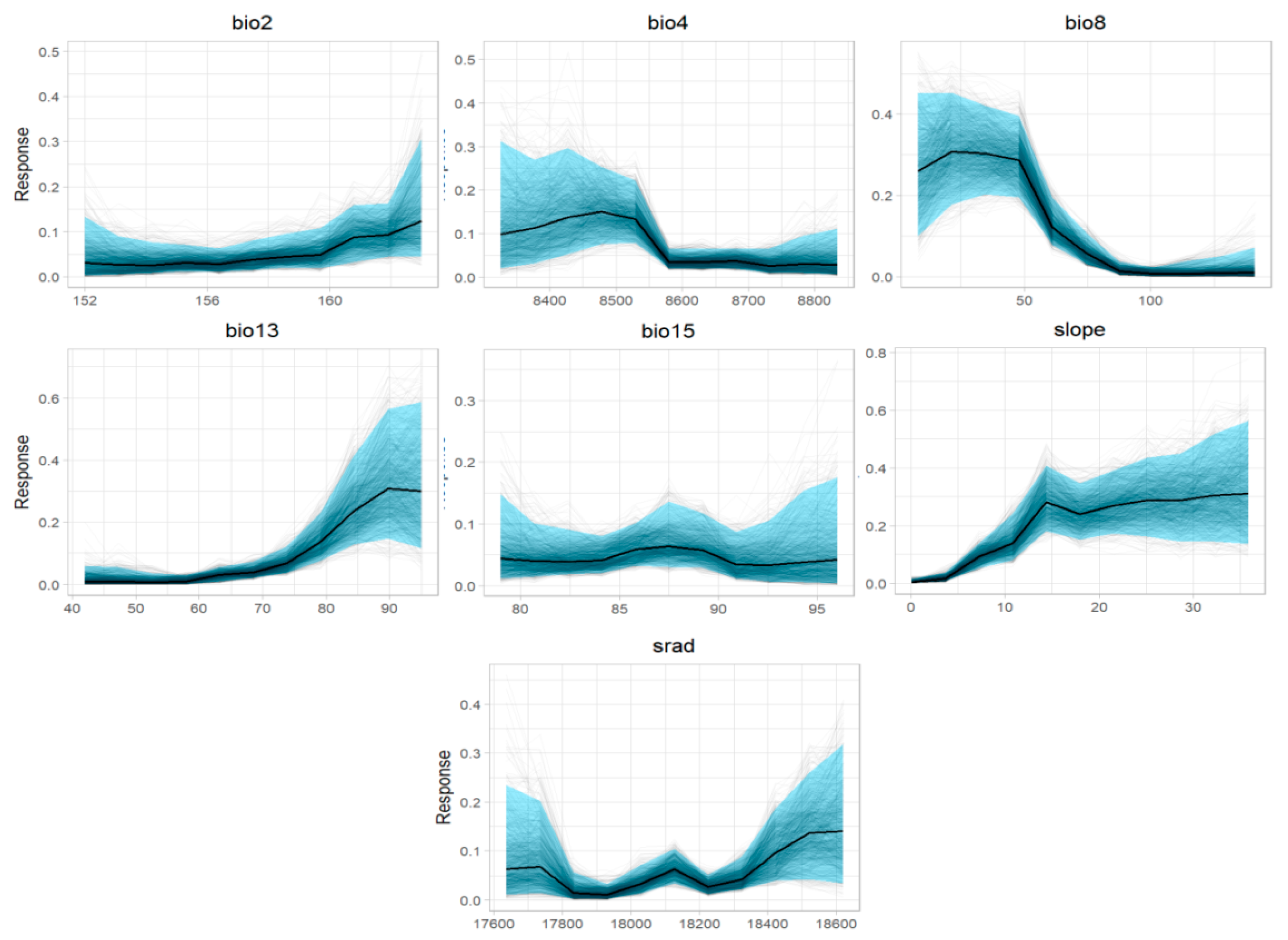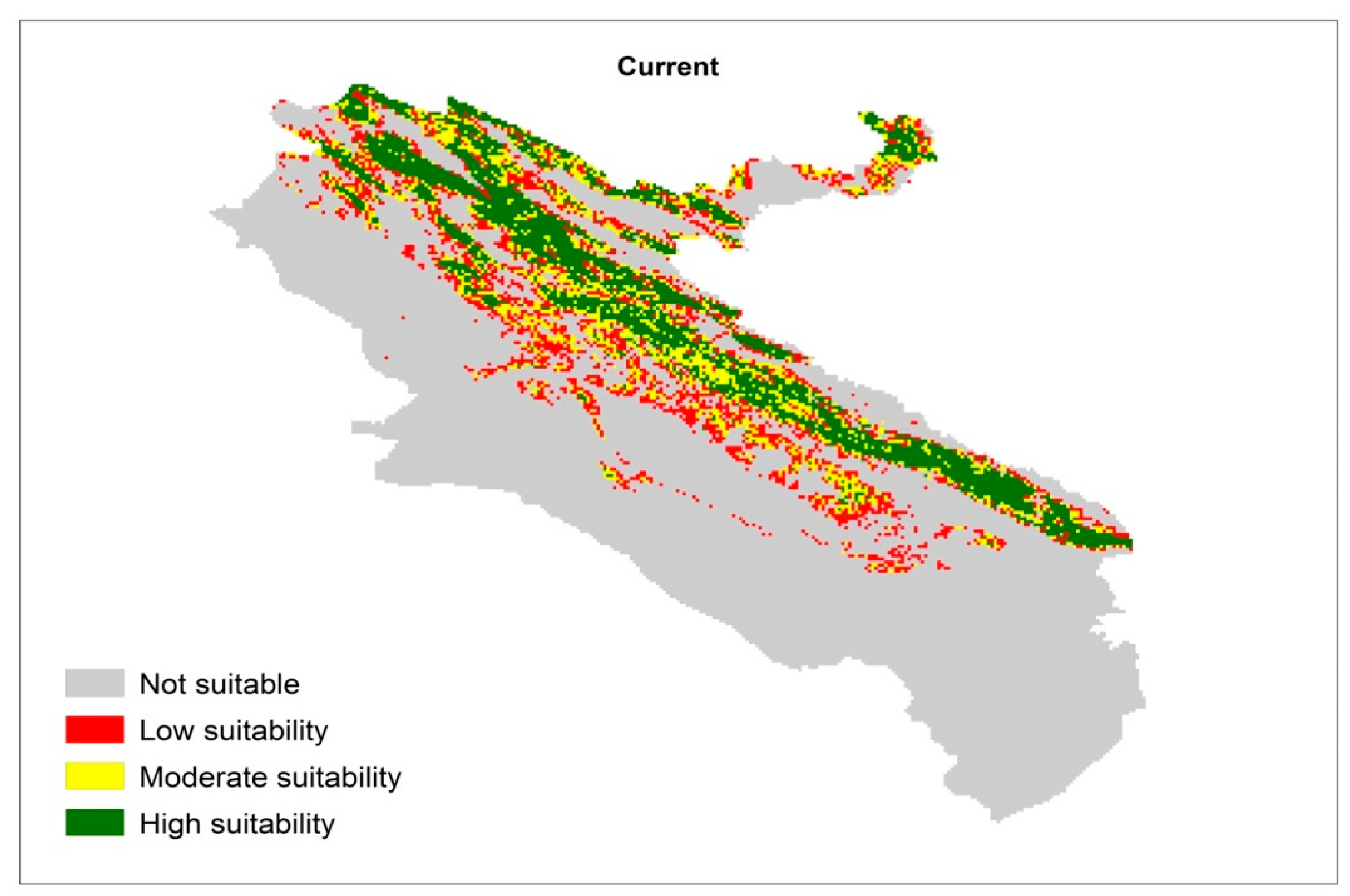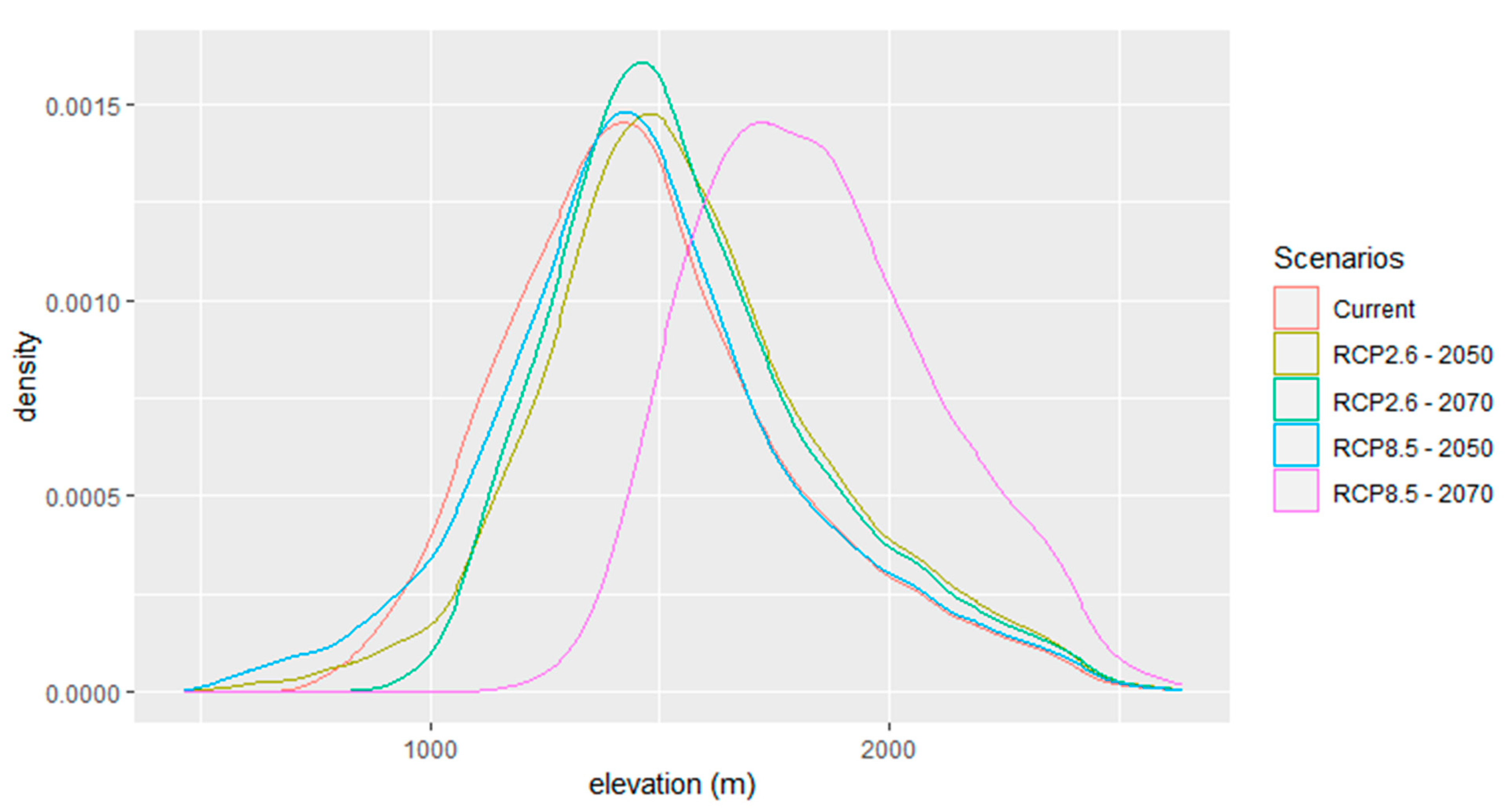Modeling Climate Change Effects on the Distribution of Oak Forests with Machine Learning
Abstract
1. Introduction
2. Material and Methods
2.1. Study Area
2.2. Species Occurrence Data
2.3. Environmental Variables
2.4. Species Distribution Modeling
2.5. Model Evaluation
3. Results
3.1. Performance Evaluation of Models
3.2. Importance of Environmental Variables
3.3. Response Curves
3.4. Current and Future Potential Distribution of Persian Oak
3.5. Elevation and Distribution of Persian Oak
4. Discussion
5. Conclusions
Author Contributions
Funding
Institutional Review Board Statement
Informed Consent Statement
Data Availability Statement
Acknowledgments
Conflicts of Interest
References
- Jonašova, M.; Prach, K. Central-European mountain spruce (Picea abies (L.) Karst.) forests: Regeneration of tree species after a bark beetle outbreak. Ecol. Eng. 2004, 23, 15–27. [Google Scholar] [CrossRef]
- Lindner, M.; Maroschek, M.; Netherer, S.; Kremer, A.; Barbati, A.; Garcia-Gonzalo, J.; Seidl, R.; Delzon, S.; Corona, P.; Kolström, M.; et al. Climate change impacts, adaptive capacity, and vulnerability of European forest ecosystems. For. Ecol. Manag. 2010, 259, 698–709. [Google Scholar] [CrossRef]
- Maclean, I.M.D.; Wilson, R.J. Recent ecological responses to climate change support predictions of high extinction risk. Proc. Natl. Acad. Sci. USA 2011, 108, 12337–12342. [Google Scholar] [CrossRef] [PubMed]
- Bellard, C.; Bertelsmeier, C.; Leadley, P.; Thuiller, W.; Courchamp, F. Impacts of climate change on the future of biodiversity. Ecol. Lett. 2012, 15, 365–377. [Google Scholar] [CrossRef]
- Abatzoglou, J.T.; Williams, A.P. Impact of anthropogenic climate change on wildfire across western US forests. Proc. Natl. Acad. Sci. USA 2016, 113, 11770–11775. [Google Scholar] [CrossRef]
- Stevens-Rumann, C.S.; Kemp, K.B.; Higuera, P.E.; Harvey, B.J.; Rother, M.T.; Donato, D.C.; Morgan, P.; Veblen, T.T. Evidence for declining forest resilience to wildfires under climate change. Ecol. Lett. 2018, 21, 243–252. [Google Scholar] [CrossRef]
- Manthey, M.; Box, E.O. Realized climatic niches of deciduous trees: Comparing western Eurasia and eastern North America. J. Biogeogr. 2007, 34, 1028–1040. [Google Scholar] [CrossRef]
- Sáenz-Romero, C.; Lamy, J.-B.; Ducousso, A.; Musch, B.; Ehrenmann, F.; Delzon, S.; Cavers, S.; Chałupka, W.; Dağdaş, S.; Hansen, J.K.; et al. Adaptive and plastic responses of Quercus petraea populations to climate across Europe. Glob. Chang. Biol. 2017, 23, 2831–2847. [Google Scholar] [CrossRef]
- Guisan, A.; Zimmermann, N.E. Predictive habitat distribution models in ecology. Ecol. Model. 2000, 135, 147–186. [Google Scholar] [CrossRef]
- Mahmoodi, S.; Heydari, M.; Ahmadi, K.; Khwarahm, N.R.; Karami, O.; Almasieh, K.; Naderi, B.; Bernard, P.; Mosavi, A. The current and future potential geographical distribution of Nepeta crispa Willd., an endemic, rare and threatened aromatic plant of Iran: Implications for ecological conservation and restoration. Ecol. Indic. 2022, 137, 108752. [Google Scholar] [CrossRef]
- Wiens, J.A.; Stralberg, D.; Jongsomjit, D.; Howell, C.A.; Snyder, M.A. Niches, models, and climate change: Assessing the assumptions and uncertainties. Proc. Natl. Acad. Sci. USA 2009, 106, 19729–19736. [Google Scholar] [CrossRef] [PubMed]
- Chakraborty, A.; Joshi, P.K.; Sachdeva, K. Predicting distribution of major forest tree species to potential impacts of climate change in the central Himalayan region. Ecol. Eng. 2016, 97, 593–609. [Google Scholar] [CrossRef]
- Fatemi, S.S.; Rahimi, M.; Tarkesh, M.; Ravanbakhsh, H. Predicting the impacts of climate change on the distribution of Juniperus excelsa M. Bieb. in the central and eastern Alborz Mountains, Iran. iForest 2018, 11, 643–650. [Google Scholar] [CrossRef]
- Valavi, R.; Shafizadeh-Moghadam, H.; Matkan, A.; Shakiba, A.; Mirbagheri, B.; Kia, S.H. Modelling climate change effects on Zagros forests in Iran using individual and ensemble forecasting approaches. Theor. Appl. Climatol. 2019, 137, 1015–1025. [Google Scholar] [CrossRef]
- Song, Y.G.; Petitpierre, B.; Deng, M.; Wu, J.P.; Kozlowski, G. Predicting climate change impacts on the threatened Quercus arbutifolia in montane cloud forests in southern China and Vietnam: Conservation implications. For. Ecol. Manag. 2019, 444, 269–279. [Google Scholar] [CrossRef]
- Khwarahm, N.R. Mapping current and potential future distributions of the oak tree (Quercus aegilops) in the Kurdistan Region, Iraq. Ecol. Process. 2020, 9, 56. [Google Scholar] [CrossRef]
- López-Sánchez, C.A.; Castedo-Dorado, F.; Cámara-Obregón, A.; Barrio-Anta, M. Distribution of Eucalyptus globulus Labill. in northern Spain: Contemporary cover, suitable habitat and potential expansion under climate change. For. Ecol. Manag. 2021, 481, 118723. [Google Scholar] [CrossRef]
- Ahmadi, K.; Alavi, S.J.; Amiri, G.Z.; Hosseini, S.M.; Serra-Diaz, J.M.; Svenning, J.C. The potential impact of future climate on the distribution of European yew (Taxus baccata L.) in the Hyrcanian Forest region (Iran). Int. J. Biometeorol. 2020, 64, 1451–1462. [Google Scholar] [CrossRef]
- Purohit, S.; Rawat, N. MaxEnt modeling to predict the current and future distribution of Clerodendrum infortunatum L. under climate change scenarios in Dehradun district, India. Model. Earth Syst. Environ. 2022, 8, 2051–2063. [Google Scholar] [CrossRef]
- Koç, D.E.; Biltekin, D.; Ustaoğlu, B. Modelling potential distribution of Carpinus betulus in Anatolia and its surroundings from the Last Glacial Maximum to the future. Arab. J. Geosci. 2021, 14, 1186. [Google Scholar] [CrossRef]
- Shafer, S.L.; Bartlein, P.J.; Thompson, R.S. Potential changes in the distributions of western north America tree and shrub taxa under future climate scenarios. Ecosystems 2001, 4, 200–215. [Google Scholar] [CrossRef]
- Austin, M.P.; Van Niel, K.P. Improving species distribution models for climate change studies: Variable selection and scale. J. Biogeogr. 2011, 38, 1–8. [Google Scholar] [CrossRef]
- Rehfeldt, G.E.; Crookston, N.L.; Sáenz-Romero, C.; Campbell, E.M. North American vegetation model for land-use planning in a changing climate: A solution to large classification problems. Ecol. Appl. 2012, 22, 119–141. [Google Scholar] [CrossRef] [PubMed]
- Chang, T.; Hansen, A.J.; Piekielek, N. Patterns and variability of projected bioclimatic habitat for Pinus albicaulis in the Greater Yellowstone Area. PLoS ONE 2014, 9, e111669. [Google Scholar] [CrossRef]
- Guisan, A.; Thuiller, W. Predicting species distribution: Offering more than simple habitat models. Ecol. Lett. 2005, 8, 993–1009. [Google Scholar] [CrossRef]
- Joseph, L.N.; Maloney, R.F.; Possingham, H.P. Optimal allocation of resources among threatened species: A project prioritization protocol. Conserv. Biol. 2009, 23, 328–338. [Google Scholar] [CrossRef]
- Levin, N.; Watson, J.E.M.; Joseph, L.N.; Grantham, H.S.; Hadar, L.; Apel, N.; Perevolotsky, A.; DeMalach, N.; Possingham, H.P.; Kark, S. A framework for systematic conservation planning and management of Mediterranean landscapes. Biol. Conserv. 2013, 158, 371–383. [Google Scholar] [CrossRef]
- Booth, T.H.; Nix, H.A.; Busby, J.R.; Hutchinson, M.F. BIOCLIM: The first species distribution modelling package, its early applications and relevance to most current MaxEnt studies. Divers. Distrib. 2014, 20, 1–9. [Google Scholar] [CrossRef]
- Zhao, Q.; Yu, S.; Zhao, F.; Tian, L.; Zhao, Z. Comparison of machine learning algorithms for forest parameter estimations and application for forest quality assessments. For. Ecol. Manag. 2019, 434, 224–234. [Google Scholar] [CrossRef]
- Hernández, B.; Raftery, A.E.; Pennington, S.R.; Parnell, A.C. Bayesian additive regression trees using Bayesian model averaging. Stat. Comput. 2018, 28, 869–890. [Google Scholar] [CrossRef]
- Sagheb-Talebi, K.; Sajedi, T.; Pourhashemi, M. Forests of Iran: A Treasure from the Past, a Hope for the Future; Springer: Berlin/Heidelberg, Germany, 2014. [Google Scholar]
- Shiravand, H.; Hosseini, S.A. A new evaluation of the influence of climate change on Zagros oak forest dieback in Iran. Theor. Appl. Climatol. 2020, 141, 685–697. [Google Scholar] [CrossRef]
- Pourhashemi, M.; Marvi Mohajer, M.R.; Zobeiri, M.; Zahedi Amiri, G.; Panahi, P. Identification of forest vegetation units in support of government management objectives in Zagros forests, Iran. Scand. J. For. Res. 2004, 19, 72–77. [Google Scholar] [CrossRef]
- Khalyani, A.H.; Mayer, A.L. Spatial and temporal deforestation dynamics of Zagros forests (Iran) from 1972 to 2009. Landsc. Urban Plan. 2013, 117, 1–12. [Google Scholar] [CrossRef]
- Ahmadi, R.; Kiadaliri, H.; Mataji, A.; Kafaki, S. Oak forest decline zonation using AHP model and GIS technique in Zagros forests of Ilam province. J. Biodivers. Environ. Sci. 2014, 4, 141–150. [Google Scholar]
- Hosseini, A.; Hosseini, S.M.; Linares, J.C. Site factors and stand conditions associated with Persian oak decline in Zagros mountain forests. For. Syst. 2018, 26, e014. [Google Scholar] [CrossRef]
- Karami, M.; Heydari, M.; Sheykholeslami, A.; Eshagh Nimvari, M.; Omidipour, R.; Yuan, Z.; Prevosto, B. Dieback intensity but not functional and taxonomic diversity indices predict forest productivity in different management conditions: Evidence from a semi-arid oak forest ecosystem. J. Arid Land 2022, 14, 225–244. [Google Scholar] [CrossRef]
- Najafi-Harsini, F.; Oladi, R.; Pourtahmasi, K.; Souto-Herrero, M.; García-González, I. Using tree-ring width and earlywood vessel features to study the decline of Quercus brantii Lindl in Zagros forests of Iran. Eur. J. For. Res. 2022, 141, 379–393. [Google Scholar] [CrossRef]
- Eskandari, S.; Jaafari, M.R.; Oliva, P.; Ghorbanzadeh, O.; Blaschke, T. Mapping land cover and tree canopy cover in Zagros forests of Iran: Application of Sentinel-2, Google Earth, and field data. Remote Sens. 2020, 12, 1912. [Google Scholar] [CrossRef]
- Moradi, M.; Jorfi, M.R.; Basiri, R.; Yusef Naanaei, S.; Heydari, M. Beneficial effects of livestock exclusion on tree regeneration, understory plant diversity, and soil properties in semiarid forests in Iran. Land Degrad. Dev. 2022, 33, 324–332. [Google Scholar] [CrossRef]
- Safaei, M.; Rezayan, H.; Firouzabadi, P.Z.; Sadidi, J. Optimization of species distribution models using a genetic algorithm for simulating climate change effects on Zagros forests in Iran. Ecol. Inform. 2021, 63, 101288. [Google Scholar] [CrossRef]
- Malekian, M.; Sadeghi, M. Predicting impacts of climate change on the potential distribution of two interacting species in the forests of western Iran. Meteorol. Appl. 2019, 27, e1800. [Google Scholar] [CrossRef]
- Chipman, H.A.; George, E.I.; McCulloch, R.E. BART: Bayesian additive regression trees. Ann. Appl. Stat. 2010, 4, 266–298. [Google Scholar] [CrossRef]
- Fattahi, M. Zagros Oak Forests and the Most Important Degradation Factors; Research Institute of Forests and Rangelands: Tehran, Iran, 1994; p. 64. [Google Scholar]
- Team, R.C. R: A Language and Environment for Statistical Computing; R Foundation for Statistical Computing: Vienna, Austria, 2021. [Google Scholar]
- Hijmans, R.J.; Cameron, S.E.; Parra, J.L.; Jones, P.G.; Jarvis, A. Very high resolution interpolated climate surfaces for global land areas. Int. J. Climatol. 2005, 25, 1965–1978. [Google Scholar] [CrossRef]
- Chatterjee, S.; Hadi, A.S. Regression Analysis by Example; John Wiley and Sons: Hoboken, NJ, USA, 2006. [Google Scholar]
- Dormann, C.F.; Elith, J.; Bacher, S.; Buchmann, C.; Carl, G.; Carré, G.; Marquéz, J.R.G.; Gruber, B.; Lafourcade, B.; Leitão, P.J.; et al. Collinearity: A review of methods to deal with it and a simulation study evaluating their performance. Ecography 2013, 36, 27–46. [Google Scholar] [CrossRef]
- IPCC. Climate Change 2014: Synthesis Report. Contribution of Working Groups I, II and III to the Fifth Assessment Report of the Intergovernmental Panel on Climate Change; Pachauri, R.K., Meyer, L.A., Eds.; IPCC: Geneva, Switzerland, 2014. [Google Scholar]
- Prado, E.B.; Moral, R.A.; Parnell, A.C. Bayesian additive regression trees with model trees. Stat. Comput. 2021, 31, 20. [Google Scholar] [CrossRef]
- Phillips, S.J.; Anderson, R.P.; Schapire, R.E. Maximum entropy modeling of species geographic distributions. Ecol. Model. 2006, 190, 231–259. [Google Scholar] [CrossRef]
- Gassó, N.; Thuiller, W.; Pino, J.; Vilà, M. Potential distribution range of invasive plant species in Spain. NeoBiota 2012, 12, 25–40. [Google Scholar]
- Hosmer, D.W.; Lemeshow, S.; Sturdivant, R.X. Applied Logistic Regression; John Wiley and Sons:: Hoboken, NJ, USA, 2013. [Google Scholar]
- Allouche, O.; Tsoar, A.; Kadmon, R. Assessing the accuracy of species distribution models: Prevalence, kappa and the true skill statistic (TSS). J. Appl. Ecol. 2006, 43, 1223–1232. [Google Scholar] [CrossRef]
- Carlson, C.J. embarcadero: Species distribution modelling with Bayesian additive regression trees in R. Methods Ecol. Evol. 2020, 11, 850–858. [Google Scholar] [CrossRef]
- Yen, J.D.L.; Thomson, J.R.; Vesk, P.A.; Mac Nally, R. To what are woodland birds responding? Inference on relative importance of in-site habitat variables using several ensemble habitat modelling techniques. Ecography 2011, 34, 946–954. [Google Scholar] [CrossRef]
- Desta, F.; Colbert, J.J.; Rentch, J.S.; Gottschalk, K.W. Aspect induced differences in vegetation, soil, and microclimatic characteristics of an Appalachian watershed. Castanea 2004, 69, 92–108. [Google Scholar] [CrossRef]
- Coban, H.O.; Cosgun, S. The role of topography in the spatial distribution of tree species in the Mediterranean region of Turkey. Fresenius Environ. Bull. 2020, 29, 1369–1378. [Google Scholar]
- Babalik, A.A.; Sarikaya, O.; Orucu, O.K. The current and future compliance areas of Kermes oak (Quercus coccifera L.) under climate change in Turkey. Fresenius Environ. Bull. 2021, 30, 406–413. [Google Scholar]
- Çoban, H.O.; Örücü, Ö.K.; Arslan, E.S. MaxEnt modeling for predicting the current and future potential geographical distribution of Quercus libani Olivier. Sustainability 2020, 12, 2671. [Google Scholar] [CrossRef]
- Al-Qaddi, N.; Vessella, F.; Stephan, J.; Al-Eisawi, D.; Schirone, B. Current and future suitability areas of kermes oak (Quercus coccifera L.) in the Levant under climate change. Reg. Environ. Chang. 2017, 17, 143–156. [Google Scholar] [CrossRef]
- Shirk, A.J.; Cushman, S.A.; Waring, K.M.; Wehenkel, C.A.; Leal-Sáenz, A.; Toney, C.; Lopez-Sanchez, C.A. Southwestern white pine (Pinus strobiformis) species distribution models project a large range shift and contraction due to regional climatic changes. For. Ecol. Manag. 2018, 411, 176–186. [Google Scholar] [CrossRef]
- Alavi, S.J.; Ahmadi, K.; Hosseini, S.M.; Tabari, M.; Nouri, Z. The response of English yew (Taxus baccata L.) to climate change in the Caspian Hyrcanian Mixed Forest ecoregion. Reg. Environ. Chang. 2019, 19, 1495–1506. [Google Scholar] [CrossRef]
- Akyol, A.; Örücü, Ö.K.; Arslan, E.S. Habitat suitability mapping of stone pine (Pinus pinea L.) under the effects of climate change. Biologia 2020, 75, 2175–2187. [Google Scholar] [CrossRef]
- Sun, S.; Zhang, Y.; Huang, D.; Wang, H.; Cao, Q.; Fan, P.; Yang, N.; Zheng, P.; Wang, R. The effect of climate change on the richness distribution pattern of oaks (Quercus L.) in China. Sci. Total Environ. 2020, 744, 140786. [Google Scholar] [CrossRef]








| Variables | Description | Unit | Use for Modeling |
|---|---|---|---|
| BIO1 | Annual Mean Temperature | °C | 🗴 |
| BIO2 | Mean Diurnal Range | °C | ✔ |
| BIO3 | Isothermality | % | 🗴 |
| BIO4 | Temperature Seasonality | % | ✔ |
| BIO5 | Maximum Temperature of Warmest Month | °C | 🗴 |
| BIO6 | Minimum Temperature of Coldest Month | °C | 🗴 |
| BIO7 | Temperature Annual Range (BIO5-BIO6) | °C | 🗴 |
| BIO8 | MT of Wettest Quarter | °C | ✔ |
| BIO9 | MT of Driest Quarter | °C | 🗴 |
| BIO10 | MT of Warmest Quarter | °C | 🗴 |
| BIO11 | MT of Coldest Quarter | °C | 🗴 |
| BIO12 | Annual Precipitation | mm/m2 | 🗴 |
| BIO13 | Precipitation of Wettest Month | mm/m2 | ✔ |
| BIO14 | Precipitation of Driest Month | mm/m2 | 🗴 |
| BIO15 | Precipitation Seasonality | % | ✔ |
| BIO16 | Precipitation of Wettest Quarter | mm/m2 | 🗴 |
| BIO17 | Precipitation of Driest Quarter | mm/m2 | 🗴 |
| BIO18 | Precipitation of Warmest Quarter | mm/m2 | 🗴 |
| BIO19 | Precipitation of Coldest Quarter | mm/m2 | 🗴 |
| Slope | % | ✔ | |
| Solar Radiation | kJ m−2 day−1 | ✔ |
| Model | AUC | Cutoff | TSS | Type I Error | Type II Error |
|---|---|---|---|---|---|
| BART | 0.93 | 0.34 | 0.75 | 0.08 | 0.16 |
| GLM | 0.86 | - | 0.68 | - | - |
| Not Suitable | Low Suitability | Moderate Suitability | High Suitability | Loss | Stable | Gain | |
|---|---|---|---|---|---|---|---|
| Current | 14,211.66 | 1708.57 | 1603.58 | 2524.36 | |||
| RCP 2.6–2050 | 15,234.4 | 1935.68 | 1319.53 | 1561.8 | 1809 | 4622 | 115 |
| RCP 2.6–2070 | 15,108.56 | 1605.39 | 1212.76 | 2123.45 | 1655 | 4776 | 417 |
| RCP 8.5–2050 | 13,704.13 | 2553.58 | 1809.15 | 1980.43 | 1267 | 5164 | 993 |
| RCP 8.5–2070 | 18,296.81 | 811.68 | 524.19 | 424.44 | 4827 | 1604 | 2 |
Disclaimer/Publisher’s Note: The statements, opinions and data contained in all publications are solely those of the individual author(s) and contributor(s) and not of MDPI and/or the editor(s). MDPI and/or the editor(s) disclaim responsibility for any injury to people or property resulting from any ideas, methods, instructions or products referred to in the content. |
© 2023 by the authors. Licensee MDPI, Basel, Switzerland. This article is an open access article distributed under the terms and conditions of the Creative Commons Attribution (CC BY) license (https://creativecommons.org/licenses/by/4.0/).
Share and Cite
Mirhashemi, H.; Heydari, M.; Karami, O.; Ahmadi, K.; Mosavi, A. Modeling Climate Change Effects on the Distribution of Oak Forests with Machine Learning. Forests 2023, 14, 469. https://doi.org/10.3390/f14030469
Mirhashemi H, Heydari M, Karami O, Ahmadi K, Mosavi A. Modeling Climate Change Effects on the Distribution of Oak Forests with Machine Learning. Forests. 2023; 14(3):469. https://doi.org/10.3390/f14030469
Chicago/Turabian StyleMirhashemi, Hengameh, Mehdi Heydari, Omid Karami, Kourosh Ahmadi, and Amir Mosavi. 2023. "Modeling Climate Change Effects on the Distribution of Oak Forests with Machine Learning" Forests 14, no. 3: 469. https://doi.org/10.3390/f14030469
APA StyleMirhashemi, H., Heydari, M., Karami, O., Ahmadi, K., & Mosavi, A. (2023). Modeling Climate Change Effects on the Distribution of Oak Forests with Machine Learning. Forests, 14(3), 469. https://doi.org/10.3390/f14030469







